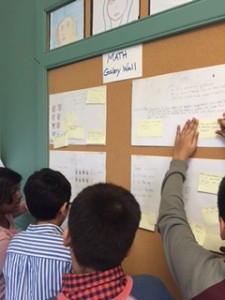 Literacy is woven into our day. We do not have “literacy centres”, but we do have learning centres that include literacy. We have shared reading, independent reading, formal writing times that look like a Writer’s Workshop, and purposeful writing that happens around the classroom such as writing cards, letters, making books and recording observations.
Literacy is woven into our day. We do not have “literacy centres”, but we do have learning centres that include literacy. We have shared reading, independent reading, formal writing times that look like a Writer’s Workshop, and purposeful writing that happens around the classroom such as writing cards, letters, making books and recording observations.
There is no “language block”, instead language is used in our morning circle to share our feelings and connect with one another. It is used during read a-louds to teach conventions of books, visualization, sequence, and voice. We learn how to spell familiar words and we learn how to use rich language to describe and express our ideas. Books are connected to our math lessons and science inquiries. We share books that enjoy reading over and over again, and we read new books on the computers and listen to stories using BookFlix.
When I started my new classroom in September, there were limited literacy resources. I acquired a variety of picture books from family and friends and I used the books from our school library to fill the shelves and reading bins. To organize the books, we designated one display rack for hardcover books and another for softcover books. I remember the day that we discussed how to tell the difference. Even now, some children knock on their book to determine which shelf it should be returned to. This also provides a daily opportunity for sorting – see how literacy is never a stand-alone in Kindergarten!
One of the first things I noticed was how rough the children were with the books. It took months of reminders and practice for the children not to throw the books, step on them, or pull at them and rip pages. You would assume that by Kindergarten children would know how to handle books, but for many children in the class handling the books in a gentle and respective manner was not familiar to them. To assist in their practice, we modelled then asked the children to “close your books gently, carry them like a cake, and place them face out on the appropriate book rack”. Now the children are much more aware of the condition of the books, and often come to me with concern that a page has ripped or torn, and ask that it be fixed with tape.
Back in September, there were no (maybe a few) levelled readers for the Kindergarten classrooms. This was the biggest concern for me, as I believe in the consistent use of levelled books to develop readers in the classroom. Through the suggestion of an instructional leader, I was able to order paper copies of what are considered replacement books and use these for a book borrowing program and for work with individuals or small groups in the classroom. These books have been invaluable for my students. Although I do not assign homework in Kindergarten, I do set up a book bag program that allows children to take home a book at their level and write about their book in an accompanying journal. There are not assigned days to take or return a book, therefore it is a program that can suit the families and their schedules. I have some students who return their book bags every day or every other day, while other students may return their bag within a week or two. All of the SK students (and a few JK students) have moved up in levels, but most importantly they feel successful as readers. The levelled readers have not been a “requirement” of the childrens’ day or have they felt pressure to read. By providing them with a book at their level (mostly all at level 1 in September) they felt excited to take a book home and then felt successful because they could actually read it. This encouraged them to continue with the program and become independent readers!

Levelled books for Book Bag Program






